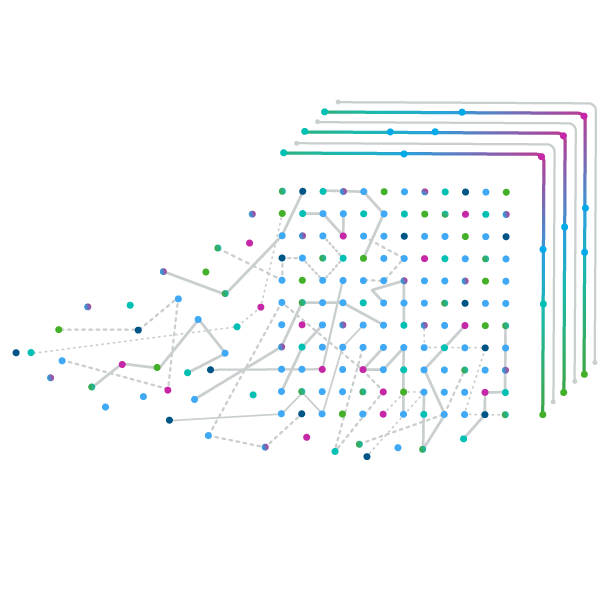See how we partner with organizations across the healthcare ecosystem, from emerging biotechnology and large pharmaceutical, to medical technology, consumer health, and more, to drive human health forward.
Lessons learned from the COVID-19 pandemic show that strengthening pandemic prevention, preparedness and response from a collaborative standpoint is a priority for global health security. Monitoring the behavior of current, emerging or resistant pathogens, particularly those with pandemic potential, rests at the center of these efforts and constitutes a first line of defense against health emergencies, including the development of preventive and therapeutic solutions. However, if datapoints from national and regional surveillance systems are not properly integrated or if they fail to activate multi-stakeholder response mechanisms, the probability of new outbreaks becomes extremely high. These risks are also amplified by the impact of climate change on human and animal health and the exacerbation of antimicrobial resistance (AMR).
While the international community is aware of the need for more and better disease surveillance, one of the key issues at hand is the design and roll out of systems that capture and process the right data, so that it can inform appropriate and timely clinical decisions. Deploying these systems, alongside appropriate governance standards, also requires an active dialogue across public and private stakeholders through a well-established value chain.
IQVIA, the Coalition for Epidemic Preparedness Innovations (CEPI) and the Global Fund co-hosted a panel on 15 January 2024 during the World Economic Forum (WEF)’s Annual Meeting in Davos to examine the critical paths and levers to move collaborative surveillance from concept to action. The welcome address was delivered by Sarah Rickwood, Vice-President, EMEA Thought Leadership, IQVIA, and the panel discussion was moderated by Alistair Grenfell, President, Europe, Middle East, Africa and South Asia and Global Head of Public Health, IQVIA. The panel convened global health and private sectors leaders such as David Marlow, Chief Executive Officer (ad interim) at Gavi; Eloise Todd, Executive Director of the Pandemic Action Network; Jilian Sacks, Global Health Policy Director at Roche Diagnostics; Peter Sands, Executive Director of the Global Fund; and Richard Hatchett, Chief Executive Officer at CEPI. The event initiated with keynotes from Dr. Jean Kaseya, Director-General of the Africa Centers for Disease Prevention and Control and Dr. Umar Saif, Pakistan’s Federal Minister of IT and Telecommunications.

From the left: Jilian Sacks, Roche Diagnostics; David Marlow, Gavi; Alistair Grenfell, IQVIA; (standing) Dr. Umar Saif, Pakistan’s Federal Ministry of IT and Telecommunications; Richard Hatchett, CEPI; Eloise Todd, Pandemic Action Network
Discussions resulted in six key takeaways:
- Disease surveillance must network health- and non-health-related data. The diversity of sources involved in disease surveillance is directly proportional to the value that can be extracted from them to support decision-making. The recombination of various types of intelligence is a valuable tool to address the ever-evolving complexities of human and animal health, allowing for more accurate, relevant, and equitable interventions. Clearly defining the healthcare milieu should consider data assets that touch upon, for example, climate change dynamics, sanitation, and a myriad of other social determinants. Data sources should be standardized, interoperable and available across national borders to facilitate international collaboration and swift and well-articulated responses to potential threats.
- Surveillance-driven action requires a strong technical infrastructure. Surveillance data is only helpful if collected through strong systems, processes and practices that can ‘separate signals from noise,’ assisting decision-makers in understanding what threats merit the triggering of resource-intensive efforts associated with vaccine development and other pertinent tools. For surveillance efforts to have an impact and reach its intended results, governments and health agencies must continue investing in, among other things, the capacity strengthening of health workers, who are ultimately tasked with interpreting and acting on the information generated by surveillance systems. This is extremely important for achieving the ambitions of CEPI’s 100-day mission, which seeks to prevent the spread of the next ‘Disease X’ by producing safe, effective vaccines and therapeutic and screening tools within 100 days of the threat’s identification.
- Surveillance should function as a permanent, silo-crossing health system capability, not leaving any diseases or conditions behind. While more robust surveillance can identify emerging threats and trigger appropriate actions to mitigate them, monitoring the behavior and managing the impact of current sets of diseases continue to be a major public health priority. Data provided by surveillance platforms can effectively steer the development and distribution of innovative solutions to rapidly respond to outbreaks, but it should also routinely do the same for infectious and non-communicable diseases with high mortality rates, particularly in low- and middle-income countries. In the opinion of some of the panelists, the international community should avoid the temptation to reserve urgent responses and investment to exclusively tackle health emergencies with a global scope, especially when affecting high-income countries, recommending that other active epidemics in more vulnerable geographies are not neglected. Moving away from strategies to carefully monitor and reduce the incidence of HIV, tuberculosis or malaria could see potential setbacks that revert decades of progress in the control of these diseases. Failing to keep track of the evolution of AMR as another major threat to global health, veering away from the possibility of incentivizing innovation or optimizing medical practices to fight it, could also have long-lasting devastating effects on society.
- Successful responses to health emergencies depend on sufficient preparation and long-term upfront investments. Preventing and preparing for health emergencies is an ongoing responsibility of governments and other public health stakeholders. In addition to fully operational disease surveillance systems, readiness can also be translated into the local manufacturing of the solutions necessary to address outbreaks, including diagnostic tests, therapeutic solutions and vaccines. An optimal pandemic response must also ensure that clinical research infrastructure is functional and well resourced, medical countermeasures and other health technologies can reach the last mile, and life-saving services are easily accessible. In this context, political leadership is paramount in leading the way and maintaining domestic and international momentum. Panelists agreed on the importance of breaking the cycle of ‘panic and neglect,’ a phenomenon in which an acute sense of urgency around pandemic preparedness is often followed by a ‘lowered guard’ that negatively impacts reaction capacity when crises arise. Civil society actors also play a central role in maintaining collective engagement around these activities, ensuring that national and regional plans of action are inclusive, opportune and community centered.
- Better surveillance needs to protect the integrity of minorities and vulnerable populations. With the erosion of human rights in many countries, characterized in many cases by the persecution of minorities and other vulnerable groups, disease surveillance data should be collected and managed under strict privacy protocols. Panelists recognized that the is no single answer to this challenge and suggested that setting up solid policy frameworks is a good first step to protect sensitive patient information and preserve the integrity of at-risk populations.
- Partnerships are the only way forward. Pandemic prevention, preparedness and response, which lists collaborative surveillance as one of its main components, is multimodal and deeply interconnected. Successful disease surveillance, often referred to as ‘disease intelligence,’ can only materialize through the active engagement of diverse actors coming from both the public and private sectors. The reason for this is twofold: first, multi-sectoral and interdisciplinary collaboration fosters innovation and creative thinking; and second, having additional actors at the table can mobilize resources that complement traditional public funding and present different avenues for long-term, sustainable financing.
Being one step ahead the next ‘Disease X,’ providing innovative tools to keep current epidemics at bay and tracking the progress of existing threats, must rely heavily on robust surveillance systems that connect diverse patient data within and beyond national borders. As the panel concluded, given the complexity of the present challenges, forming these systems and the required infrastructure around them can only happen by combining the expertise, innovative approaches, convening power, financial and human resources, political capital and advocacy muscle of national governments, regional groupings, multilateral organizations, the private sector and civil society.
Find out more about our Commitment to Public Health and feel free to contact us.

Related solutions
Use big data and predictive analytics to improve human health.


























